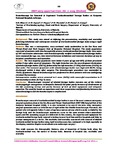Bronchoscopy for Removal of Aspirated Tracheobronchial Foreign Bodies at Kenyatta National Hospital, in Kenya

View/
Date
2013Author
Oburra, HO
Ngumi, ZW
Masinde, PW
Maina, AW
Irungu, C
Metadata
Show full item recordAbstract
This study was aimed at defining the presentation, morbidity and mortality following inhalation and subsequent removal of tracheobronchial foreign body using a rigid bronchoscope.This was a retrospective, cross-sectional study undertaken in the Ear Nose and Throat-Head and Neck Surgery Unit of Kenyatta National Hospital. The study population consisted of patients with brochoscopically proven tracheobronchial foreign body. Case notes of 107 consecutive admissions with brochoscopically verified tracheobronchial foreign bodies were analyzed for age, sex, time interval between inhalation and removal, duration of stay in hospital, complications and mortality The vast majority of patients were below 3 years of age and 63% of them presented within 3 days after onset of symptoms. The right bronchus was the most frequent destination
of inhaled foreign bodies (50.5%) followed by the left bronchus (17.8%) and carina (14.2%) in that order. The turnover of patients with inhaled foreign bodies was high with 86.9% being discharged within 6 days after surgery. The bronchoscopic procedure was uneventful in 76.6% of patients. Repeat bronchoscopy was performed in three patients with one undergoing
eventual thoracotomy. Intraoperative cardiac arrest occurred in 5 cases (4.6%) with successful resuscitation in 2
and mortality in three (2.7%) % cases.Bronchoscopic removal of inhaled foreign bodies remains one of the riskiest
otolaryngologic emergencies in Kenyatta National Hospital partly because of involvement of the life sustaining airway and partly because of lack of ideal equipment and adequate expertise. The need for hands on experience and close cooperation and familiarity between the anaesthesiologist and the bonchoscopist is emphasized.
